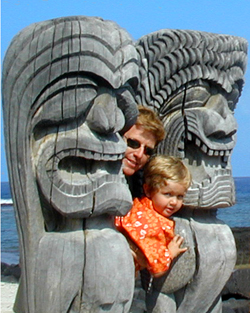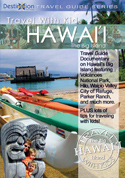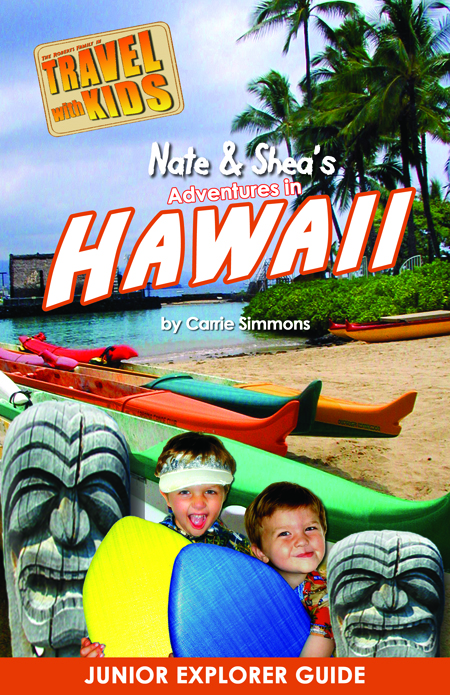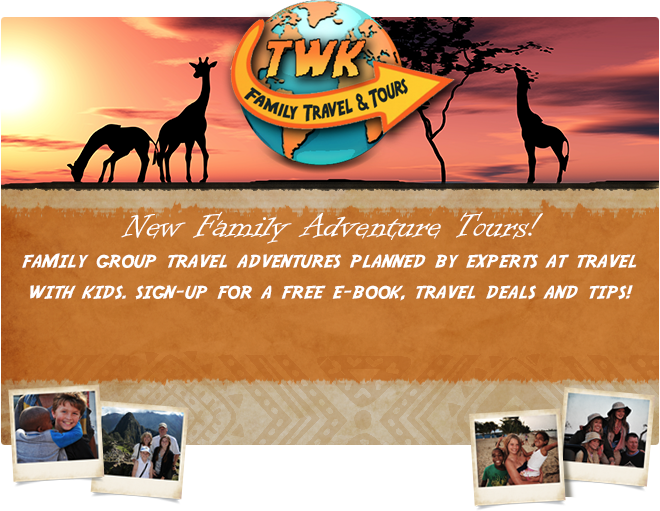Hawaii: The Big Island With Kids
The Big Island of Hawaii is just that, big. And with all that room it has plenty of adventure waiting for the traveler willing to explore it. On the south side of the island, Kilauea Volcano is the world’s most active and usually stuns visitors with its pyrotechnics show. The Big Island’s east shore is home to Hawaii’s capital, Hilo, which is the wettest place in the United States. The west shore is known for its drier climate and sunshine. Most of the big resorts are located along the coast north of Kona.
VIEW THE WHOLE HALF-HOUR EPISODE AS SEEN ON PBS, HULU, iTUNES AND MORE!
 Kilauea – Volcanoes National Park
Kilauea – Volcanoes National Park
One of the most active volcanoes in the world, Kilauea is the main attraction in Hawaii Volcanoes National Parkwhere visitors can see hardened lava flows, feel and smell (think rotten eggs) volcanic gases steaming from cracks in the earth, hike through lava tunnels, and, if they’re lucky, view active lava oozing down the hillside to the ocean below. An interactive museum explains how the Hawaiian islands were formed and the continued volcanic process (some of the newest land on earth is formed here on the Big Island). Affects of the volcanic activity can be seen all along the west coast of the Big Island, but if you are looking for more stellar volcano, you can drive up the side of Mauna Loa, the world’s biggest volcano and take a peek at the heavens at the Mauna Kea Visitors Information Center.
Kona and the West Coast
The Big Island of Hawaii’s west coast is all sunshine and beaches and therefore attracts the bulk of the tourists. It’s an arid environment with lots of lava rock…even the highway grafitti is made from black lava rock and white coral. To get a bit of Hawaiian culture in on this coast visit Pu’uhonua o Honaunau (or if that’s too much of a mouthful, City of Refuge) National Park. The park can be entered on a combined ticket with Volcanoes National Park and hosts a rich Hawaiian history as the place where elderly and children could go during wars to avoid harm…a philosophy unheard of in this area during the time that King Kamehameha created it. It was also an asylum for breakers of kapu, the series of laws regarding conduct in the Kingdom of Hawai’i, if broken often times the punishment was death. Kids like the huge ki’i (large, carved wooden statues) which are still carved on premises to constantly replenish the guardian statues of the bay. The kids also loved playing konane, a Hawaiian version of checkers played with lava rocks.
Just outside the town of Kona, we visited Kona Lea Plantation, an organic coffee plantation where the kids like hiking through the orchards picked coffee berries off the tree and learning about the harvesting and roasting process. We all enjoy tasting the fresh brew in the visitor’s center…it gives quite a kick!
Just up the street, we swam with dolphins at the Hilton Waikoloa Village. The village resort features ocean view pools, canals and lagoons filled with boats and kayaks, a train tram running from the main building to the beachfront, oceanfront golf putting course and more. In the oceanfront lagoon, the resort hosts Dolphin Quest, a dolphin interaction program with a focus on marine education. We went waist deep into a gradual incline sandy bottom and learned about the dolphin, petting him and feeding him. It was amazing to see how fast he moved under the water.
Hilo and the East Coast
The east coast of the island is much wetter and, therefore, much greener than the west coast. In fact Hilo is the wettest city in the United States, receiving some rain an average of 275 days per year. On the way to Hilo, we stopped at Waipi’o Valley, for an incredible view over the first of seven sacred valleys on the Hamakua Coast. Hiking into the valley is a popular activity, but we thought the kids were a bit too young for the climb at the time, so we decided to try the hike to ‘Akaka Falls just down the road. But before we leave the area, the bell boy at our resort insist we try the malasadas (Portuguese doughnuts) at Tex Drive-In. And, was he right! The kids loved watching the pastries being made through the huge plate glass window and we all enjoyed the scrumptious taste of the hot, sweet bread and fruity or creamy filling. The path to ‘Akaka Falls is an easy cement decent with a few steep staircases. It winds through superb tropical rainforest and past lookouts over two amazing falls, Kahuna Falls and ‘Akaka Falls, which plunges almost 500 feet down a moss-covered gorge.
Hilo Farmers Market offers a good education on tropical fruits with over 200 vendors selling local foods and fruits, plants and crafts. The boys enjoy trying interesting varieties of mango and jack fruit and looking at all the bizarre shaped tropical flowers. But their favorite part about Hilo was the Pana ‘ew Rainforest Zoo where tropical birds and turtles share billing with the white tigers. The monkey enclosure, which featured a tunnel shape fence that went straight through the center of the cage, gave us an upclose view of squirrel monkeys and the kids liked watching the tiger feeding.
Parker Ranch
At the center of the island is one of the USA’s biggest and oldest ranches, Parker Ranch. Established in 1847, this working ranch is open to tourists offering horseback riding, hunting and horse-drawn carriage rides. There is also a museum that tells the story of the paniolo, the Hawaiian cowboy.
Family-Friendly Places to Stay on The Big Island of Hawaii
Located on the sunny Kohala coast, we stayed at the Hapuna Beach Prince Hotel, which shares 1800 acres with Rockefeller’s luxury creation, sister hotel Mauna Kea Beach Hotel. The hotel is great for kids. It has a quiet beach front with sand toys, an excellent snorkeling area where we saw honu (or turtles), large lawn area with hammocks, game area and dive-in movies at the oceanview pool. Plus, the kids have lots of fun in the keiki club, or kid’s club, painting t-shirts, learning to make leis and more.
Getting to The Big Island of Hawaii
The Big Island can be accessed by air and sea. There are two major airports on the Big Island, Hilo International Airport on the island’s east coast and Kona International Airport on the west coast. There are a few direct flights to the island. American, Delta and United fly directly from the mainland United States to Kona and Hawaiian Airlines flies through Honolulu to both Kona and Hilo. go! Mokulele offers hundreds of daily inter-island flights. Hawaiian Superferry was running interisland service by water, but has shut down. The only option for transfer on the water is by private charter.
Getting Around The Big Island of Hawaii
The Big Island is big and therefore driving around it takes a long time (6 – 8 hours to drive around the island; about 4 hours between Hilo and Kona). The Big Island’s public transportation, Hele-On Bus, provides free transportation around the island including a route from Kona to Hilo and routes past the City of Refuge and Volcanoes National Park. If you want more freedom to explore off the bus path, most of the major rental car companies have cars available on the island. For 4WD and motorhomes, try Harper Car and Truck Rental with offices in Kona and Hilo.
on Twitter
on Facebook
on Google+

















Leave a Reply
You must be logged in to post a comment.